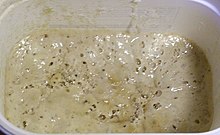1ºeso/the microorganisms and fermentations/task5 to be returned on April the 27th
In these strange times for everyone, we have seen that in many establishments it is not possible to get certain ingredients for cooking. One of them is baker's yeast to make bread. This yeast is produced by a type of single-celled fungus. So it occurred to me that you could bring the laboratory back to your home for two purposes: to cultivate this mushroom to make sourdough as a substitute for industrial yeast, and the other to learn how to make your own homemade bread.
The sourdough is a symbiotic culture of the yeasts naturally present in foods, such as cereals, especially yeasts such as Saccharomyces cerevisiae, also responsible for the fermentation of wine and beer, and bacteria present in the environment.
Sourdough made up of flour and water after two days of fermentation.
Traditionally, it has served to ferment bread, before commercial yeast existed.
It is usually made from cereals such as wheat or rye. Bakers from before save the sourdough, either in a liquid state or as a piece of dough (separated from the bread just before baking), for the daily preparation of the bread incorporating flour and the other elements that the composition will be made of. bread. The yeast strains of the sourdough are relatively resistant to low temperatures (more than those of commercial yeast) so they can be stored "alive" by feeding them with flour and water; or in a passive state, numb at low temperatures, for example in the fridge (always above zero) .https://es.wikipedia.org/wiki/Masa_madre
Click the following link and start working: sourdough
Observe what happens every day and document it with a daily photograph that you will send me along with the following questions:
1. Why raisins are added
2. Why milk is added
3. Why it bubbles
4. Why it may smell bad
5. Why is temperature important
The sourdough is a symbiotic culture of the yeasts naturally present in foods, such as cereals, especially yeasts such as Saccharomyces cerevisiae, also responsible for the fermentation of wine and beer, and bacteria present in the environment.
Sourdough made up of flour and water after two days of fermentation.
Traditionally, it has served to ferment bread, before commercial yeast existed.
It is usually made from cereals such as wheat or rye. Bakers from before save the sourdough, either in a liquid state or as a piece of dough (separated from the bread just before baking), for the daily preparation of the bread incorporating flour and the other elements that the composition will be made of. bread. The yeast strains of the sourdough are relatively resistant to low temperatures (more than those of commercial yeast) so they can be stored "alive" by feeding them with flour and water; or in a passive state, numb at low temperatures, for example in the fridge (always above zero) .https://es.wikipedia.org/wiki/Masa_madre
Click the following link and start working: sourdough
Observe what happens every day and document it with a daily photograph that you will send me along with the following questions:
1. Why raisins are added
2. Why milk is added
3. Why it bubbles
4. Why it may smell bad
5. Why is temperature important


Comentarios
Publicar un comentario